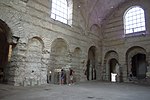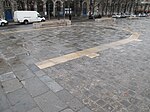Île de la Cité

Île de la Cité (French: [il də la site]; English: City Island) is an island in the river Seine in the center of Paris. In the 4th century, it was the site of the fortress of the Roman governor. In 508 Clovis I, the first King of the Franks, established his palace on the island. In the 12th century it became an important religious center, the home of Notre-Dame cathedral, and the royal chapel of Sainte-Chapelle, as well as the city's first hospital: the Hôtel-Dieu. It is also the site of the city's oldest surviving bridge, the Pont Neuf. With the departure of the French kings to the Louvre Palace and then to the Palace of Versailles, the island became France's judicial centre. In 1302 it hosted the first meeting of the Parliament of Paris and was later the site of the trials of aristocrats in the French Revolution. Today, it is the home of the Prefecture de Police, the Palais de Justice, and the Tribunal de commerce de Paris. The Mémorial des Martyrs de la Déportation, a memorial to the 200,000 people deported from Vichy France to the Nazi concentration camps during the Second World War, is located at the eastern end of the island. The city's most famous landmark, Notre-Dame de Paris, was badly damaged by a fire in 2019 and is closed, but it is expected to reopen in time for the Paris Olympics in 2024. As of 2016, the island's population was 891.
Excerpt from the Wikipedia article Île de la Cité (License: CC BY-SA 3.0, Authors, Images).Île de la Cité
Place Louis Lépine, Paris 4th Arrondissement (Paris)
Geographical coordinates (GPS) Address Nearby Places Show on map
Geographical coordinates (GPS)
| Latitude | Longitude |
|---|---|
| N 48.854722222222 ° | E 2.3475 ° |
Address
Cité - Parvis Notre-Dame
Place Louis Lépine
75004 Paris, 4th Arrondissement (Paris)
Ile-de-France, France
Open on Google Maps










